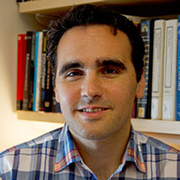- Level Foundation
- المدة 5 ساعات hours
- الطبع بواسطة University of Pennsylvania
-
Offered by

عن
How do revolutions emerge without anyone expecting them? How did social norms about same sex marriage change more rapidly than anyone anticipated? Why do some social innovations take off with relative ease, while others struggle for years without spreading? More generally, what are the forces that control the process of social evolution –from the fashions that we wear, to our beliefs about religious tolerance, to our ideas about the process of scientific discovery and the best ways to manage complex research organizations? The social world is complex and full of surprises. Our experiences and intuitions about the social world as individuals are often quite different from the behaviors that we observe emerging in large societies. Even minor changes to the structure of a social network - changes that are unobservable to individuals within those networks - can lead to radical shifts in the spread of new ideas and behaviors through a population. These “invisible” mathematical properties of social networks have powerful implications for the ways that teams solve problems, the social norms that are likely to emerge, and even the very future of our society. This course condenses the last decade of cutting-edge research on these topics into six modules. Each module provides an in-depth look at a particular research puzzle -with a focus on agent-based models and network theories of social change -and provides an interactive computational model for you try out and to use for making your own explorations! Learning objectives - after this course, students will be able to... - explain how computer models are used to study challenging social problems - describe how networks are used to represent the structure of social relationships - show how individual actions can lead to unintended collective behaviors - provide concrete examples of how social networks can influence social change - discuss how diffusion processes can explain the growth social movements, changes in cultural norms, and the success of team problem solvingالوحدات
Introduction
1
Videos
- 1.0 Course Introduction and Objectives
Thomas Schelling’s Segregation Model
6
Videos
- 1.1 The Substantive Problem: Micromotives and Macrobehavior
- 1.2 What are Agent-Based Models?
- 1.3 Formal Model of Segregation
- 1.4 Exploring Schelling's Segregation Model
- 1.5 How to Download and Use NetLogo
- 1.6 Using NetLogo: Schelling's Segregation Model
Quiz: Week 1
1
Assignment
- Week 1
Network Science
4
Videos
- 2.1 Network Science: Mapping a Connected World
- 2.2 Introduction to Network Science
- 2.3 Types of Networks: Lattice Graph
- 2.4 Types of Networks: Random Graph
NetLogo
2
Videos
- 2.5 Using NetLogo: Properties of the Small World Network
- 2.6 Using NetLogo: Information Diffusion in Small World Networks
Conclusion
1
Videos
- 2.7 Conclusions: Life in a Small World
Quiz: Week 2
1
Assignment
- Week 2
Social Contagions
6
Videos
- 3.1 Social Contagions: Beyond Information Diffusion
- 3.2 From Simple to Complex Contagions
- 3.3 How to Model Complex Contagions
- 3.4 Threshold Models in Networks
- 3.5 Using NetLogo: Complex Contagions in Small World Networks
- 3.6 Conclusion: The Spread of Behavior in a Complex World
Week 3 Quiz
1
Assignment
- Week 3
The Emperor's Dilemma and The Spread of Unpopular Norms
6
Videos
- 4.1 The Emperor's Dilemma: Explaining Unpopular Norms
- 4.2 Components of a Norm: Compliance and Enforcement
- 4.3 Modeling Compliance and Enforcement
- 4.4 Using NetLogo: Explaining the Spread of Unpopular Norms
- 4.5 Falsification and Sufficiency in the Emperor's Dilemma
- 4.6 Self-Reinforcing Norms: A Cautionary Conclusion
Week 4 Quiz
1
Assignment
- Week 4
The Spontaneous Emergence of Conventions
5
Videos
- 5.1 A Startup Problem: The Emergence of Norms
- 5.2 Conventions and the Challenge of Coordination
- 5.3 Modelling Pairwise Coordination in Networks
- 5.4 Using NetLogo: Coordination in Networks
- 5.5 How do norms emerge? Global Agreement from Peer-to-Peer Interation
1
Readings
- Optional Reading: Creating Critical Mass
Week 5 Quiz
1
Assignment
- Week 5
Networks of Innovation
7
Videos
- 6.1 Exploration and Exploitation: Networks of Innovation
- 6.2 Modeling Complex Problems
- 6.3 Modeling Problem-Solving in Teams
- 6.4 Thinking about Models: Problem-Solving in the Real World
- 6.5 Using NetLogo: Complex Problem Solving in Networks
- 6.6 Conclusions: The Two Pizza Rule
- 6.7 Course Conclusions: The Network Dynamics of Social Behavior
Week 6 Quiz
1
Assignment
- Week 6
Auto Summary
Explore the fascinating "Network Dynamics of Social Behavior" course in Personal Development, presented by Coursera. Delve into the forces driving social evolution, from cultural shifts to scientific discovery. Instructor-led and rich with agent-based models, this foundational course spans six modules over 300 minutes. Ideal for those curious about social change, it offers interactive computational models and insights into the invisible properties of social networks. Available through Starter and Professional subscriptions, this course empowers learners to understand and influence social dynamics. Perfect for anyone interested in the complexities of social behavior and change.

Damon Centola


